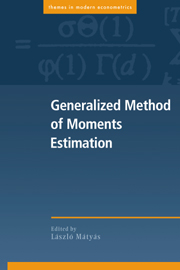Book contents
- Frontmatter
- Contents
- Contributors
- Preface
- 1 Introduction to the Generalized Method of Moments Estimation
- 2 GMM Estimation Techniques
- 3 Covariance Matrix Estimation
- 4 Hypothesis Testing in Models Estimated by GMM
- 5 Finite Sample Properties of GMM estimators and Tests
- 6 GMM Estimation of Time Series Models
- 7 Reduced Rank Regression Using GMM
- 8 Estimation of Linear Panel Data Models Using GMM
- 9 Alternative GMM Methods for Nonlinear Panel Data Models
- 10 Simulation Based Method of Moments
- 11 Logically Inconsistent Limited Dependent Variables Models
- Index
11 - Logically Inconsistent Limited Dependent Variables Models
Published online by Cambridge University Press: 04 February 2010
- Frontmatter
- Contents
- Contributors
- Preface
- 1 Introduction to the Generalized Method of Moments Estimation
- 2 GMM Estimation Techniques
- 3 Covariance Matrix Estimation
- 4 Hypothesis Testing in Models Estimated by GMM
- 5 Finite Sample Properties of GMM estimators and Tests
- 6 GMM Estimation of Time Series Models
- 7 Reduced Rank Regression Using GMM
- 8 Estimation of Linear Panel Data Models Using GMM
- 9 Alternative GMM Methods for Nonlinear Panel Data Models
- 10 Simulation Based Method of Moments
- 11 Logically Inconsistent Limited Dependent Variables Models
- Index
Summary
Simultaneous equations models involving limited dependent variables can have nonunique reduced forms, a problem called logical inconsistency in the econometrics literature. In response to that problem, such models can be compelled to be recursive (Maddala [1983], Amemiya [1985]) or recast in terms of the latent variables (Mallar [1977]). In labor economics and elsewhere, this approach is often contrary to structural modelling; theory involving education, childbearing, and work, for example, naturally leads to models with simultaneously related limited dependent variables. Restricting these models to be recursive is inconsistent with the theory.
It is widely believed among economists that logically inconsistent models cannot be data generating processes (see Amemiya [1974] and Maddala [1983]). However, Jovanovic [1989] showed that the structural form of a model with nonunique reduced forms can be identified. That raises the possibility that these models can produce outcomes which are random variables even if the process is logically inconsistent.
An alternative interpretation of these models is that they can generate more than one equilibrium for the endogenous variables for some values of the exogenous variables and disturbances. Viewed this way, the problem can be solved by using a selection rule (Dagsvik and Jovanovic [1991], Goldfeld and Quandt [1968]], Hamilton and Whiteman [1985]) or collapsing the possibly nonunique equilibria into one outcome for purposes of estimation (Bresnahan and Reiss [1991]).
This chapter combines the use of a selection rule to choose among alternative equilibria with the insights of Jovanovic [1989] and standard GMM estimation theory to suggest an alternative to the method of Bresnahan and Reiss [1991] to identify and estimate simultaneous equations models of limited dependent variables.
- Type
- Chapter
- Information
- Generalized Method of Moments Estimation , pp. 301 - 312Publisher: Cambridge University PressPrint publication year: 1999
- 1
- Cited by



